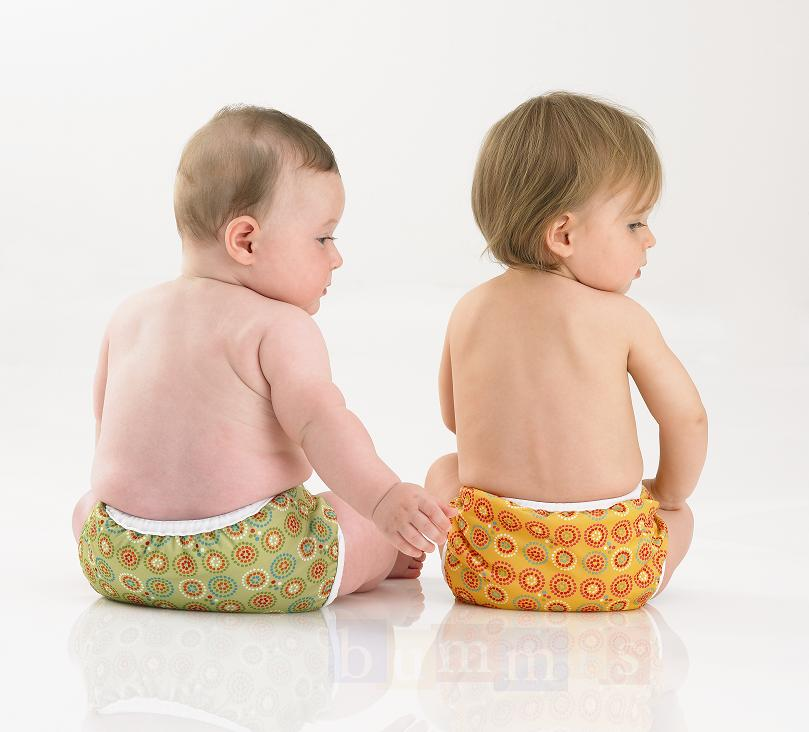Types of Cloth Diapers
Wipe away your visions of diaper pins. The cloth diaper world has revolutionized. It’s hip, trendy and loads of fun. Great patterns and color options make for super cute tushies! We explain three of the most common cloth diapering systems below.
- Diaper + Cover
- Pocket Diapers
- All-In-One Diapers
SYSTEM 1: Diaper + Cover
The cloth diaper plus cover system may be the original, but don’t let that make you think it’s in any way dated. Tons of options and great prints make this system a popular choice.
Diaper Types
Prefold/Flat – Prefolds or flats are available in a range of options, including bleached cotton, unbleached cotton and hemp/cotton blends blends. With the innovation of modern diaper covers designed to control leaks, prefolds are a great, affordable option. They can be simply folded in three lengthwise creating a long rectangle and laid inside a cover. Alternatively, you can wrap it on the baby and keep it in place with an easy to use snappi (goodbye diaper pins!) and then put a cover on top.
Examples: Bummis Organic Cotton Prefolds
Fitted – Fitted cloth diapers resemble a regular disposable diaper. Snaps or velcro make for a quick and easy fasten and gathered elastic legs help contain messes. Fitted diapers are a popular and easy to use choice, particularly for newborns and for overnight solutions in older babies. They require a cover overtop to make them waterproof.
Examples: Kissaluvs Cotton Fleece Fitted
Diaper Cover Types
All of the diaper types listed above require a diaper cover overtop or else baby’s clothes (and yours too!!!) will be a tad wet ; )
The most common diaper covers are made of the following materials:
PUL – Polyurethane Laminate is waterproof and stands up well to regular use
Wool – A popular choice given the natural fibers, its breathability and the ability to repel water.
Also fitting into the Diaper + Cover category are the new hybrid systems such as the bumGenius flip or GroVia . Hybrid systems, also often referred to as all-in-two diapers, allow you to simply tuck or snap absorbent material into a cover with your choice of either a reusable soaker (organic / stay dry) or a disposable insert. The covers can be re-used multiple times without washing provided they are not soiled. These systems are essentially a modern take on the traditional prefold + cover system.
SYSTEM TWO: Pocket Diapers
Pocket cloth diapers most typically consist of a waterproof outer PUL cover and a microfleece, microsuede or cotton interior which touches the baby’s skin.
Pocket diapers have an opening either at the front or back in which you can add extra stuffing between the outer PUL layer and inner fleece/suede lining. The “stuffing” is referred to as an insert and provides the absorbency for the diaper. There are a wide range of inserts available, some of which are made of natural fibres (e.g., hemp) and others which are not (e.g., microfiber). You can tailor absorbency to suit your little one’s needs.
Once stuffed, these diapers go on and off just like a disposable. Some of the brands are even made so the inserts agitate out of the diaper in the wash all on their own!
One of the benefits of pocket diapers is that the diaper dries more quickly than traditional all-in-ones in which the absorbency is fully sewn into the diaper itself. Pocket diapers also allow you to customize absorbency for times of greater need (e.g., long car trips or overnight) versus general daytime use when changes are more frequent.
Examples: bumGenius 4.0, FuzziBunz
SYSTEM 3: All-in-Ones
All-in-One cloth diapers are typically considered the easiest diaper to use. They are in fact the closest to a disposable. Traditional all-in-ones typically consist of an outer waterproof layer, typically made of PUL, and a microfleece, cotton or microsuede inner liner that touches baby’s skin. In a traditional All-in-One, the absorbent material is sewn directly into the diaper between the PUL outer and the soft inner lining that touches the baby’s skin. This means that All-In-Ones can simply go on and off like a disposable. The primary drawback with All-in-Ones tends to be the drying time. In Pocket Diapers, the absorbency material is separate, and stuffed in and out of the pocket area, which lends faster drying times.
Examples: bumGenius Elemental, Tots Bots Easy Fit
What is the difference between a liner, doubler and insert?
Liners are placed between the baby’s skin and the cloth diaper. Liners provide a quick and easy solution to handling poop and help protect the diaper if you are using diaper creams. Fleece liners can also be added to provide a stay-dry feel for baby if your diaper is made of natural fibers.
Inserts are the absorbent part of pocket diapers. They are available in a wide range of textiles including microfiber, hemp, bamboo, etc. You can use one or more inserts per pocket diaper and even combine different kinds such as pairing a microfiber insert with a hemp insert.
Doublers are designed to provide an extra absorption boost to a diaper. They are typically placed on top of the diaper, next to baby’s skin. However, they could be added into a pocket opening as well, similar to inserts.
Previous: Why Choose Cloth - Benefits of Cloth Diapers Next: Which Cloth Diapers are Best for Us?





